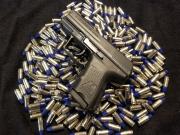Now that I hopefully got some attention with the title...
I've been working at relaxing my arms and the upper body during the weapons manipulations, specifically draw and reloads, lately. It is self-evident that one is able to move arms faster when relaxed, but shooting requires some amount of muscle tension, hands, pecs etc. to control and drive the gun. I wonder if anybody has any tricks, suggestions or exercises on how to stay relaxed throughout and only tense up when it is needed.
One of those things that I am sure is helpful is to build overall hand and upper body strength. Beyond that, I've been trying to concentrate on staying loose during dry-fire, but the dryfire is not super-helpful here since it is easy to stay relaxed when you know the gun isn't coming off (which is I think is a reason that par times with dryfire are substantially lower than with live fire where one tenses up).
Anybody has ever looked at this?




 Reply With Quote
Reply With Quote



